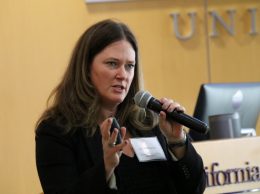Tri-county nonprofits need to adapt, innovate
By Charles Maxey and Linda Kimbrough
Trump administration budget proposals should be sending early warning signals to the nation’s nonprofit organizations. The anticipated reductions in federal and, therefore, state spending will adversely impact many populations served by charitable organizations. At the same time, the need for services continues to rise. Nonprofit Finance Fund’s 2014 study documented that, for the sixth year in a row, such demands have increased.
So, what’s a nonprofit to do? New challenges create new opportunities.
Cluster. Collaborate. Share: Look for opportunities to make the resources pie bigger by actively working with other nonprofits for mutual benefit. Jointly host events to educate and recruit new supporters. Share office space and equipment. Share staff. A full-time employee working simultaneously for two nonprofits that share the employment costs might be a more committed and engaged staff member than one you could attract for part-time pay and more limited benefits.
Use IT better: New information technology tools let you engage stakeholders in nimble and personalized ways. Mine your records databases to produce new understandings of stakeholder interests, patterns of giving and satisfaction.
Ramp up your advocacy: Advocacy engenders passion and passion is the bedrock of commitment. It is increasingly legitimate and mainstream to be militant. Witness the recent women’s marches. And advocacy is not just for politics anymore. Private sector businesses are increasingly taking public positions on societal issues and enabling their employees to work actively for social change. Develop “a bias for action.” Advocate for those you serve — make their needs known to the wider community. And advocate for yourself. Attack the “fake news” that meaningful nonprofit work can be done without overhead expenses.
Educate. Educate. Educate: Borrow concepts and tools from the private sector. Create a chief education officer to direct the strategic use of knowledge and technology. Be an active provider of information, advocacy and perspective. Use online tools to their full advantage — younger stakeholders expect and demand this. In the age of Amazon and Google, you have to bring it to them actively, rapidly and engagingly.
Follow the demographics: Millennials, those born between 1982 and 2000, now outnumber baby boomers. And, as a generation, they are more technology savvy, diverse and inclusive. Grab their attention and get them involved. The eleventy marketing group reports that 63 percent of millennials reported volunteering for nonprofits in 2011.
Ninety percent said they expected to do so in the future. Are you getting your share?
Give volunteers meaningful work: The National Council of Nonprofits argues that skilled volunteers are the new pro bono, meaning that professionals in many occupations today, not just CPAs and lawyers, are looking for chances to contribute their expertise to causes. Author Daniel Pink tells us eloquently that knowledge workers — educated people who do intellectual work — want mastery, autonomy and purpose both in their paid work and in their volunteer activities. It takes careful thought to design the more complex volunteer roles that will appeal to these people and to provide effective leadership, but the potential returns are enormous.
The Museum of Ventura County, which has several decades of experience working with boomers, has found that understanding the boomer’s expectations of volunteering is key in recruitment and retention. Boomers are seeking ways to volunteer and serve. They want flexible schedules for balancing volunteering, travel, grandchildren, aging parents or part-time jobs. Boomers remain achievement-oriented and demand that their time and effort have a meaningful impact. Boomers seek to use their skills or gain new ones through their volunteer endeavors. If they do not find one that meets them on their terms, they take their time and talents elsewhere. Many boomers are retired professionals — leaders who want to be challenged. Design roles that meet these needs.
Today’s nonprofits have many opportunities to employ new approaches to attracting and utilizing the resources they need to accomplish their missions.
• Charles Maxey is a professor of management at California Lutheran University. Linda Kimbrough is on the board of directors at the Museum of Ventura County.











